Site menu:
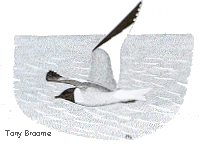
May 2013 Newsletter
Species Spotlight - Waxwings.
April Bird News.
Forthcoming Events.
Latest Newsletter.
Species Spotlight - Waxwings
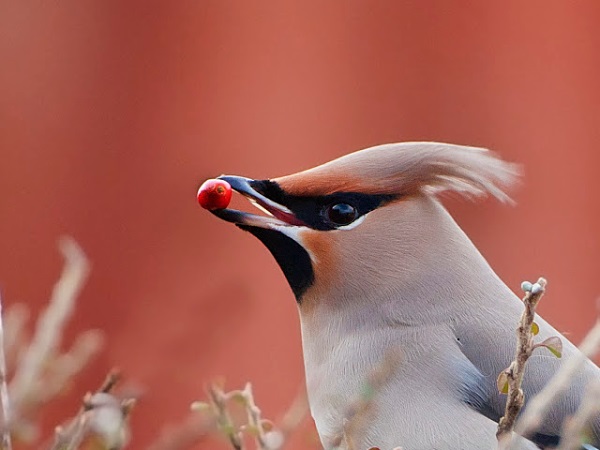
One of the reasons we birders love Waxwings is that they are so different. Not only do they look thoroughly exotic with their chestnut/pink plumage, pronounced crest and bright yellow and red waxy wing flashes, they also behave differently from other birds. Not for them wild rocky coasts, bleak moorland or species rich woodland - no, they prefer supermarket car parks and housing estates!
They
are also different as they are such a conspicuous irruption species,
most winters we don't see a single one but then we get winters like
2012/13 when they seem to be everywhere. This last winter was really
something very exceptional, as a look at the graph below shows. Without
a doubt it was the best Waxwing winter ever recorded along the shores
of the Dee Estuary and North Wirral, and I've looked at records going
back well into the 19th century! Nationally it has been a remarkable
eight years as we've had three major irruptions (2004/05, 2010/11 and
2012/13) when we would normally expect them every ten years or so. So I
hope you managed to see them last winter as we might not get any again
for over a decade!

Going back to the 20th century we had very few Waxwings reported in the Dee Estuary area. The major irruption of 1965/66 is a typical example when many hundreds were seen elsewhere in the country yet here we seem to have just had a few single figure flocks. But every 'Waxwing Winter' is different and this next graph nicely illustrates that.
In 2004/05 birds arrived late with good numbers not appearing until the fourth week of December, and most had gone by the end of January. Even though more birds were involved than the next big irruption in 2010/11 there were only 20 flocks recorded in 2004/05 with birds going around together in large numbers including over 100 in Ewloe in December and up to 93 in Greasby in January. In contrast there there were 60 flocks in 2010/11 but most flock sizes were less than 20 birds. Birds arrived early that winter with three on Oct 24th. But they were virtually absent during January and February and it wasn't until mid-March that we saw birds heading north again.

In 2012/13 they arrived early with 10 on Nov 9th, they built up rapidly so by the following week the weekly total was 378 with many birds in Deeside Industrial Estate. There were a lot of birds in Wirral as well and flocks stayed all winter albeit with a quiet period in January. Returning flocks were early and the total number of records for the first week in February was 443, the highest number of the winter. A total of 111 flocks were logged with the largest being 100 at Deeside Industrial Park on Nov 17th, most flocks were between 20 and 50 strong and widespread.
Irruptions occur when there aren't
enough berries in Scandinavia for the Waxwings to eat. Some years there
is a complete failure of the berry crop and that happened in 2010 and
2012, which is why birds arrived early and in such numbers into the
country. In 2004 there were berries available but very wet weather
meant that these rotted and it was then that birds moved south. Other
irruptions occur when the Waxwings have had a
particularly good breeding season, the sheer numbers of birds means
that the berries cannot last all winter and
birds move south and reach this country later in the winter, often not
until the New Year.
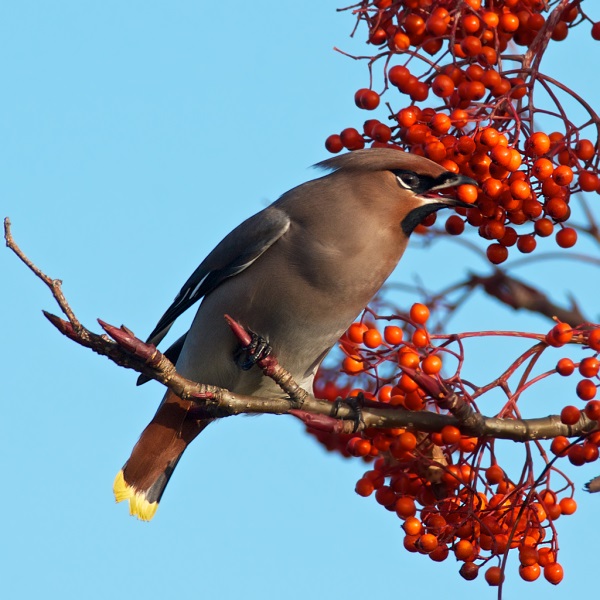
Why the Waxwings arrived in such good
numbers into
our area this last
winter I don't know, but large flocks arriving in Scotland in the
autumn do seem to have split up early and became widespread, and
obviously they found plenty of food here in our housing estates and
supermarket car parks. It will be interesting to see whether the last
12 years will be typical of what to expect in the future with big
irruptions occurring every three or four years or so, or whether we
will look back and see it as a golden age for Waxwings - never to be
repeated!
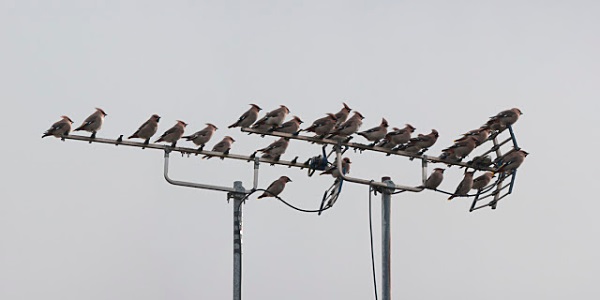
both in February 2013 and April 2011 - © Matt Thomas, see fromthemuddybanksofthedee.com
Notes:
1. The total number of records for
each week in the graphs is just that, i.e. the numbers for each flock
were summed each day then added together for the week. Undoubtedly this
exaggerates the total numbers of birds we have had - e.g. a flock of 20
staying for three days would be a total record of 60. But there is no
way of knowing how big the turnover of birds is on a daily basis, or
even if a flock of, say, 40 seen in Irby one day are the same birds
seen the following day in Heswall. But I have treated each
winter
the same so we are comparing like with like.
2. I have stuck strictly to the Dee Estuary and North Wirral coast area, so the large flock in Seacombe in 2001 is not included, nor those in Birkenhead this last winter.
References:
1. Dee Estuary Birding latest sightings
archive - www.deeestuary.co.uk.
2. The Migration Atlas, BTO, 2002.
3. Birds of the Western Palearctic (BWPi - interactive edition).
4. Cheshire and Wirral Bird Reports 1967 to 2011.
5. Clwyd/North-east Wales Bird Reports - various between 1975 and
2011.
6. Phil Oddy, Waxwing Influx 2004/05, Cheshire and Wirral Bird Report
2005.
7. David Norman, Birds in Cheshire and Wirral - a breeding and
wintering atlas, 2008.
8. R.K. Cornwallis and A.D. Townsend, Waxwings in Britain and Europe
during 1965/66, British Birds Vol.61 No.3 (March 1968).
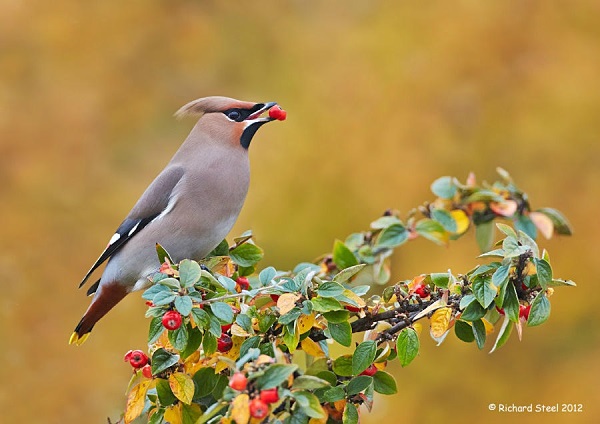
Richard Smith
April Bird News
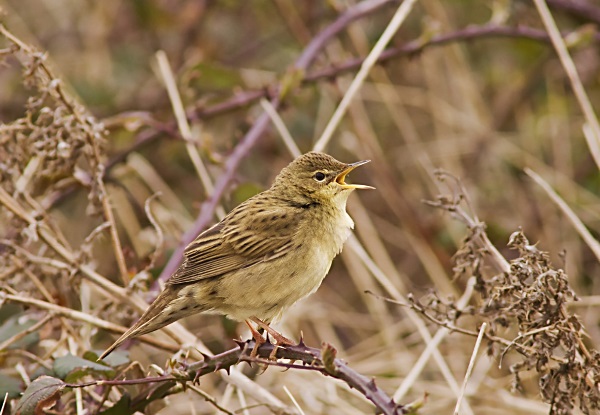
Table shows date of first arrival of Spring migrants.
| Species | 2013 | Location (2013) | 2012 | 2011 |
|---|---|---|---|---|
| White Wagtail | 14th March | Leasowe Lighthouse | 8th March | 11th March |
| Wheatear | 17th March | Leasowe Lighthouse | 9th March | 13th March |
| Sand Martin | 28th March | West Kirby | 28th Feb | 12th March |
| Willow Warbler | 6th April | Red Rocks | 20th March | 16th March |
| Swallow | 10th April | Red Rocks | 17th March | 20th March |
| House Martin | 12th April | Hilbre | 4th April | 25th March |
| Cuckoo | 13th April | Caldy | 14th April | 20th April |
| Whitethroat | 15th April | West Kirby | 1st April | 8th April |
| Swift | 17th April | Sealand |
26th April | 17th April |
As well as both winter and spring weather, we also had autumnal like westerly gales! I don't remember a better April for Manx Shearwaters with 15 records and a max of 100 at Hilbre on the 23rd, the norm is a single April record in single figures! Other sea watching highlights include 590 Gannets, a Great Skua, a Pomarine Skua, 85 Red-throated Divers and 490 Razorbills, all on the 18th, plus three Long-tailed Ducks and an Iceland Gull on the 24th.
Starting to migrate north were Black-tailed Godwits and Pink-footed Geese. The former decided to roost at the Caldy Wildfowl collection from the 15th reaching a maximum of 1,560 on the 25th. Although they have used this site before, anything over 20 or so is considered unusual. They looked magnificent in their breeding plumage, just a few yards from the busy A540. It was a thrill for me as they were just 300 yards from my house! A significant number of them were colour ringed and I'll be telling their story in a future article.
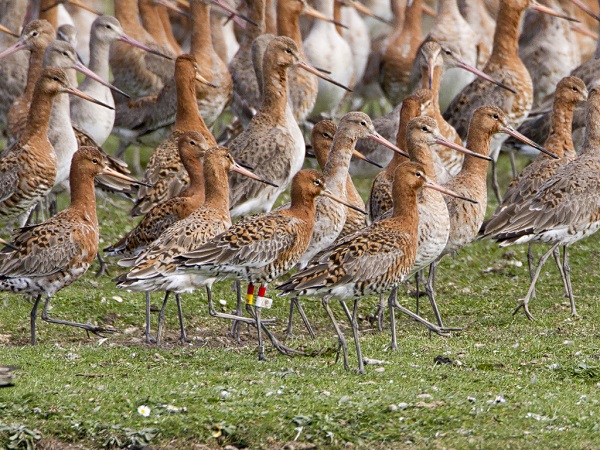
The ringed bird was ringed in Iceland as a chick in July 2011.
The cold weather must have delayed the movement north of Pink-footed Geese as there were still at least 2,000 on Burton Marsh at the beginning of the month. Those who got up early on the 13th and 20th were rewarded by seeing these birds flying overhead out of the estuary, with 1,515 on the former date and 731 on the latter, a lovely sight.
With all the excitement I almost forgot that it was also an excellent month for rarities with an American Wigeon, Blue-winged Teal, several Black-throated Divers, a Hoopoe, a Little Auk, a Red Kite and a Sabine's Gull - the latter being a particularly good April record blown in on the gales.
Richard Smith.
What to expect in May
The spring migration will still be well under way for at least the first half of the month and in the past couple of years we have had some impressive falls of Yellow Wagtails, Willow Warblers and Wheatears.
There are often good numbers of waders passing through including Spotted Redshanks in their amazing breeding plumage and plenty of Whimbrels. Avocets will be breeding at Burton Mere Wetlands and we expect another successful season.
Any strong west winds will bring impressive numbers of Gannets and other sea birds. The breeding at the Little Tern colony at Gronant will be well under way by the end of the month.
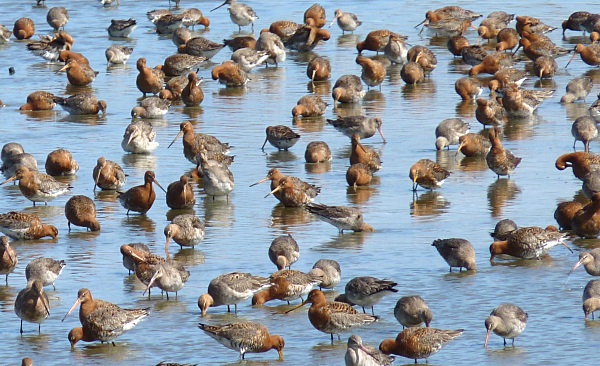
© Richard Smith.
Forthcoming Events
May Highest Spring Tides (Liverpool)
Also
see Tides
page.
26th May, 12.38hrs (BST), 9.6m.
27th May, 13.27hrs (BST), 9.6m.
Forthcoming Events
Organised by the Wirral
Ranger Service , Flintshire Countryside Service and/or the
RSPB:
All these events and walks have bird interest, even those not
advertised specifically for birdwatching. No need to book for these
events unless specified - please check below.
Also see 2013 Events Diary.
Join the Coastal rangers on a guided walk across the sands to Hilbre Island.
Here we will look for some of the wildlife that Hilbre is famous for and learn about the fascinating history of this tidal island.
Watreproofs and good walking boots are rcommended.
Bring sunblock and some binoculars.
Booking essential, please ring 0151 648 4371.
Saturday 4th May, Birdsong & Breakfast at RSPB Burton Mere Wetlands.
7.00am - 9.00am
Price: RSPB members £3; non-members £5
Booking essential, please ring 0151 353 8478.
Get down to Burton Mere Wetlands for this one-off event as part of Wirral Walking Festival.
With a wonderful mixture of woodland and wetlands is there a better place to experience the early morning birdsong?
This is a fantastic opportunity to see the reserve 'out of hours' and you'll never know what other wildlife we might bump into... stick around afterwards for a light breakfast, hot drink and the chance to explore the rest of the reserve!
Saturday 4th May, Bluebells and Birdsong at RSPB Burton Mere Wetlands.
10:00am start.
Price: RSPB members £4; non-members £8.
Booking essential, please ring 0151 353 8478.
Come along to admire one of the best bluebell woodlands in the area. This two hour guided walk through Gorse Covert, 3.4 hectares of semi-natural ancient woodland, will allow you to enjoy the flowers whilst seeing and hearing the vast array of woodland birds we have nesting here.
Stick around afterwards to enjoy the rest of the wetland reserve, and a hot drink and sweet treat in the reception hide.
Sturdy footwear is essential.
Sunday 5th May, 4:30am - 6:30am, Dawn Chorus - Royden Park.
Join the Ranger at Royden Park and listen to the fantastic sounds of nature as birds sing at this very early time of year.
Meet at Court Yard/Coach House at Royden Park.
Sorry no dogs.
Please wear warm and waterproof clothing.
Booking essential. Ring 0151 677 7594.
Sunday 5th May, Dawn Chorus at RSPB Burton Mere Wetlands.
5.00am start.
Price: RSPB members £3; non-members £5.
Booking essential, please ring 0151 353 8478.
Get down to Burton Mere Wetlands and help us celebrate International Dawn Chorus Day.
With a wonderful mixture of woodland and wetlands is there a better place to experience the dawn chorus?
This is a fantastic opportunity to see the reserve 'out of hours' and you'll never know what other wildlife we might bump into... stick around afterwards for a chat, hot drink and the chance to have the reserve to yourself for another two hours!
Friday 10th May, 10:00am, The Birds of Wirral Country Park (Thurstaston).
Join staff and volunteers from the RSPB and Coastal Rangers to discover some of the birds that can be found in the freshwater, hedgerow, woodland, grassland and estuarine habitats within and adjacent to Wirral Country Park.
This walk includes stepped access to the Dungeons.
Please bring binoculars if you have them.
Booking essential, please ring 0151 648 4371.
Saturday 11th May 6:30pm – 9:30pm
Sunset and Wildlife:
Join the Coastal Rangers and RSPB for an evening walk across the sands to Hilbre Island to discover its wildlife and history. Warm waterproof clothing, stout footwear or wellingtons are recommended. Bring binoculars if you have them.
Places are limited and a suggested donation of £3:00 will be gratefully received for this event.
Booking essential (0151) 648 4371
Saturday 1st June 10:00am – 2:00pm
Summer on Hilbre:
Join the Coastal Rangers, RSPB and Wirral Wildlife on this low tide walk to
Hilbre Island. We will see the flowers and plants that flourish on this
tidal island, learn about the birdlife and the island's history. Suitable
clothing, footwear and sunblock are recommended for this walk. Bring a
snack and something to drink along with binoculars if you have them. Places
are limited and a suggested donation of £3 will be gratefully received on
the day for this event.
Booking is essential (0151) 648 4371
Saturday 8th June 6:30pm – 9:30pm
Sunset and Wildlife:
Join the Coastal Rangers and RSPB for an evening walk across the sands to Hilbre Island to discover its wildlife and history. Warm waterproof clothing, stout footwear or wellingtons are recommended. Bring binoculars if you have them.
Places are limited and a suggested donation of £3:00 will be gratefully received for this event.
Booking essential (0151) 648 4371
